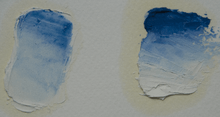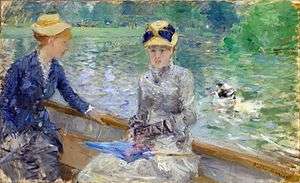Cerulean
| Cerulean | |
|---|---|
| Hex triplet | #007BA7 |
| sRGBB (r, g, b) | (0, 123, 167) |
| CMYKH (c, m, y, k) | (100, 26, 0, 35) |
| HSV (h, s, v) | (196°, 100%, 65%) |
| Source | [1] |
|
B: Normalized to [0–255] (byte) H: Normalized to [0–100] (hundred) | |
| Cerulean (RGB) | |
|---|---|
| Hex triplet | #003FFF |
| sRGBB (r, g, b) | (0, 63, 255) |
| CMYKH (c, m, y, k) | (100, 75, 0, 0) |
| HSV (h, s, v) | (225°, 100%, 100%) |
| Source | [Unsourced] |
|
B: Normalized to [0–255] (byte) H: Normalized to [0–100] (hundred) | |
Cerulean (/səˈruːliən/), also spelled caerulean, is a color term that may be applied to certain colors with the hue ranging roughly between blue and cyan, overlapping with both. It also largely overlaps with azure and sky blue, although cerulean is dimmer.
The first recorded use of cerulean as a color name in English was in 1590.[1] The word is derived from the Latin word caeruleus, "dark blue, blue, or blue-green", which in turn probably derives from caerulum, diminutive of caelum, "heaven, sky".[2]
Use in artistic painting

In classical times, cerulean was used to describe blue pigments, particularly mixtures of copper and cobaltous oxides, like azurite and smalt. These early attempts to create sky blue colors were often less than satisfactory due to a limited saturation and the tendency to discolour in reaction with other pigments. When the pigment cerulean blue (shown in the color box to the left) was discovered, it became a useful addition to Prussian blue, cobalt blue and synthetic ultramarine which already had superseded the prior pigments. See also Tekhelet.
Cerulean blue
| Cerulean Blue | |
|---|---|
| Hex triplet | #2A52BE |
| sRGBB (r, g, b) | (42, 82, 190) |
| CMYKH (c, m, y, k) | (87, 74, 0, 0) |
| HSV (h, s, v) | (224°, 78%, 75%) |
| Source | [3] |
|
B: Normalized to [0–255] (byte) H: Normalized to [0–100] (hundred) | |
At right is displayed the color cerulean blue.
The first recorded use of cerulean blue as a color name in English was in 1859.[3]
Pigments through the ages shows a "Painted swatch of cerulean blue" that is representative of the actual cobalt stannate pigment. This color swatch matches the color shown in the color box at right.[4] See also painted swatch and crystals of cerulean blue at ColourLex.[5]
Cerulean blue pigment

Cerulean blue was discovered in 1789 by Albrecht Höpfner.[6] Subsequently there was a limited German production under the name of Kölinblau. It was in 1860 first marketed in the United Kingdom by colourman George Rowney, as "coeruleum". Other nineteenth century English pigment names included "ceruleum blue" and "corruleum blue". The primary chemical constituent of the pigment is cobalt(II) stannate.[7][8][9] The precise hue of the pigment is dependent on a variable silicate component. The pigment is very expensive.
It is particularly valuable for artistic painting of skies because of its hue, its permanence, and its opaqueness.[10] Berthe Morisot painted the blue coat of the woman in her "A Summer's Day', 1879 in cerulean blue in conjunction with artificial ultramarine and cobalt blue.[11]

Today, cobalt chromate is sometimes marketed under the cerulean blue name but is darker and greener (Rex Art color index PB 36) than the cobalt stannate version (color index PB 35). The chromate makes excellent turquoise colors and is identified by Rex Art and some other manufacturers as "cobalt turquoise".[12][13]
Other variations
Pale cerulean
| Cerulean (Pantone) | |
|---|---|
| Hex triplet | #98B4D4 |
| sRGBB (r, g, b) | (152, 180, 212) |
| HSV (h, s, v) | (212°, 28%, 83%) |
| Source | Pantone TPX[14] |
|
B: Normalized to [0–255] (byte) | |
Pantone, in a press release, declared the pale hue of cerulean at right, which they call cerulean, as the "color of the millennium".[15]
The source of this color is the "Pantone Textile Paper eXtended (TPX)" color list, color #15-4020 TPX—Cerulean.[16]
Bright cerulean
| Cerulean (Crayola) | |
|---|---|
| Hex triplet | #1DACD6 |
| sRGBB (r, g, b) | (29, 172, 214) |
| HSV (h, s, v) | (209°, 94%, 49%) |
| Source | Crayola |
|
B: Normalized to [0–255] (byte) | |
This bright tone of cerulean is the color called cerulean by Crayola crayons.
Cerulean frost
| Cerulean Frost | |
|---|---|
| Hex triplet | #6D9BC3 |
| sRGBB (r, g, b) | (109, 155, 195) |
| CMYKH (c, m, y, k) | (44, 21, 0, 24) |
| HSV (h, s, v) | (208°, 44%, 77[17]%) |
| Source | Crayola |
|
B: Normalized to [0–255] (byte) H: Normalized to [0–100] (hundred) | |
At right is displayed the color cerulean frost.
Cerulean frost is one of the colors in the special set of metallic colored Crayola crayons called Silver Swirls, the colors of which were formulated by Crayola in 1990.
In nature
- Cerulean cuckooshrike
- Cerulean kingfisher
- Cerulean paradise flycatcher
- Cerulean warbler
- Cerulean-capped manakin
In human culture
- Color
- Cerulean was nominated by Pantone in 1999 as the "color of the millennium".[18] (See the color pale cerulean above)
- Automotive
- Used as a paint color by the McLaren Automotive "MSO" division.
- Computer software
- Cerulean Studios is a software house based in Connecticut, United States.
- Film
- In The Devil Wears Prada, Miranda Priestly (Meryl Streep) makes a reference to a cerulean colored sweater, and other high fashion clothes items in Cerulean.
- Literature
- Cerulean Sins is the eleventh book in the Anita Blake: Vampire Hunter series by Laurell K. Hamilton.
- Caerulean is the species of alien Rovander Kitt belongs to in The Search for WondLa series by Tony DiTerlizzi.
- Music
- Cerulean is the album title for the September 10, 1991 music release by the band The Ocean Blue.
- Cerulean is the first album by musician Baths
- Cerulean is the sixth track on the 1992 album Hoodoo Zephyr by composer John Adams.
- Cerulean is a song of the Simian Mobile Disco band, recorded on "Unpatterns" album.
- Cerulean is a track of Jon Hopkins, recorded on his album entitled "Opalescent".
- Science
- Cerulean cyan fluorescent protein is a mutant of green fluorescent protein.
- Television
- Repetition of the words "cerulean blue" is a method the "Pusher" villain uses at the beginning of the eponymous X-Files episode 17 season 3 in order to lull his victims to do what he wants.
- In the fourth season Rocky and Bullwinkle story arc Painting Theft, villain Boris Badenov adopts the guise of a fictitious art collector named "Cerulean Blue."
- In the fourth season of My Little Pony: Friendship Is Magic, reformed villain Discord becomes sick with "the blue flu" and has adopted a blue skin color, which Rarity describes as "a shade of cerulean, to be precise."
- In the first season of The Loud House, when the second eldest child Leni notices her skin had turned blue from her sister Lisa's experimental skin pigmentation ointment that Lisa swapped out for Leni's blemish cream, she corrects her by saying "it's a sallow shade of cerulean."
- Video games
- Azul the Cerulean is the blue-haired 33-year-old final recruit of the Tsviets in Dirge of Cerberus: Final Fantasy VII.
- Cerulean City is one of the pivotal locations in the game and anime Pokémon and is home to the Water Pokémon Gym in Kanto.
See also
References
- 1 2 Maerz, Aloys John; Paul, M. Rea (1930). A Dictionary of Color. McGraw-Hill Book Company. p. 190; Color Sample of Cerulean: Page 89 Plate 33 Color Sample E6.
- ↑ Cerulean, Online Etymology Dictionary
- 1 2 Maerz, Aloys John; Paul, M. Rea (1930). A Dictionary of Color. McGraw-Hill Book Company. p. 190; Color Sample of Cerulean: Page 89 Plate 33 Color Sample L9.
- ↑ "Cerulean blue". Pigments through the Ages. Retrieved 30 December 2011.
- ↑ Cerulean blue, ColourLex
- ↑ Höpfner, A., 1789, "Einige kleine Chymische Versuche vom Herausgeber", Magazin für die Naturkunde Helvetiens, herausgegeben von Albrecht Höpfner, Vierte Band, pp 41–47
- ↑ Cerulean blue (overview), Pigments of the Ages, Webexhibits.org
- ↑ History of Cerulean blue, Pigments of the Ages, Webexhibits.org
- ↑ Material Name: cerulean blue, Museum of Fine Arts, Boston
- ↑ Pigments: Historical, Chemical, and Artistic Importance of Coloring Agents, JcSparks.com
- ↑ Bomford D, Kirby J, Leighton, J., Roy A. Art in the Making: Impressionism. National Gallery Publications, London, 1990, pp. 176–181
- ↑ Blue Artist's Pigments, PaintMaking.com
- ↑ blue watercolors, handprint.com (this is a cross-reference of colors grouped by color index)
- ↑ Type the word "Cerulean" into the indicated window on the Pantone Color Finder and the color will appear.
- ↑ "Pantone press release (1999) – Cerulean blue: the color of the New Millennium":
- ↑ Pantone TPX Pantone Color Finder—Type the word "Cerulean" into the indicated window on the Pantone Color Finder and the color will appear:
- ↑ web.forrett.com Color Conversion Tool set to hex code #6D9BC3 (Cerulean Frost):
- ↑ Slate
External links
- A page on Cerulean Blue
- Cerulean blue at ColourLex